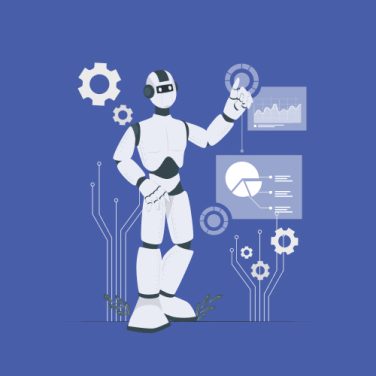The landscape of performance management is undergoing a transformation, propelled by the integration of Artificial Intelligence (AI).
Performance management itself is a fundamental component of business strategy, designed to ensure that employee efforts are in harmony with organisational goals.
It involves a continual process, where regular communication between managers and employees forms the backbone of this system.
The shift towards AI
AI is revolutionising the performance management cycle, offering innovative solutions by providing real-time data, automating data summary tasks, and aiding in feedback management, which traditionally consumed significant time and effort.
The role of AI is not only to streamline this process but also to enhance decision-making by minimising biases and bringing predictive insights, thus aligning individual goals more closely with evolving organisational strategies.
This shift enhances outcomes such as improved performance and increased engagement.
Why performance management matters

Effective performance management is crucial for both employee satisfaction and organisational success.
By systematically involving employees in the planning phase and ensuring continuous feedback, organisations can drive higher employee engagement, foster skill development, and align work processes with strategic objectives.
The application of AI in these areas can be instrumental in transforming workplace dynamics, enhancing team productivity, and empowering managers to focus more on meaningful conversations rather than paperwork.
The incorporation of AI tools, like those offered by MiHCM, exemplifies how technology can be leveraged to optimise the performance management process, driving significant enhancements in productivity and strategic decision-making.
The performance management cycle is a comprehensive process designed to evaluate and improve employee performance over time. This cyclical process encompasses four critical stages, each playing a vital role in nurturing the workforce and aligning individual endeavours with organisational goals.
Let’s delve into each of these stages to better understand their significance within the performance management process flow.
การวางแผน
Planning initiates the performance management cycle, focusing on setting clear job responsibilities and objectives that align with the organisation’s strategic goals.
In this stage, managers and employees collaborate to define expectations and performance metrics using established frameworks such as Management by Objectives (MBO).
This stage is crucial as it provides a roadmap for employees, ensuring their efforts contribute meaningfully to the company’s vision.
Monitoring
As we transition into the monitoring stage, continuous performance assessment takes precedence.
During this phase, the emphasis is on regular dialogue between managers and employees to track progress against the predefined objectives.
Utilising performance management cycle diagrams can facilitate this process by visually representing targets and achievements, thus enhancing clarity and communication.
Effective monitoring prevents potential issues from escalating, enabling timely interventions and course corrections.
Developing
Development is essential for fostering both individual growth and organisational success.
This stage involves addressing skill gaps, offering training resources, and presenting opportunities that challenge employees to excel. By nurturing talent and encouraging skill enhancement, organisations can build a resilient and future-ready workforce.
Companies that incorporate continuous development programmes often witness improved motivation and job satisfaction.
Rating and rewarding
The cycle culminates with the rating and rewarding stage, wherein employee performance is evaluated, and contributions are recognised.
Rating helps in determining the value added by the employee, guiding decisions concerning raises, promotions, or other forms of recognition. This stage promotes a culture of appreciation, boosts morale, and incentivises high performance across the organisation.
Together, these stages form a dynamic performance management cycle diagram, illustrating a seamless flow that connects planning with rewarding. Effective execution of this cycle is integral to boosting employee engagement and productivity.
The integration of Artificial Intelligence (AI) in the performance management cycle holds the potential to redefine how organisations manage their workforce. By enhancing the planning, monitoring, development, and rating stages, AI offers actionable insights, reduces biases, and augments decision-making processes.
AI in planning and monitoring
During the planning stage, AI tools assist managers by analysing vast amounts of data to predict future performance trends. This enables leaders to set realistic performance goals that are aligned with organisational objectives.
AI-driven platforms like MiHCM provide a streamlined process for managers to establish clear expectations and Key Performance Indicators (KPIs) based on analytical insights.
In the monitoring stage, AI plays a crucial role in providing real-time feedback and insights. This continuous performance monitoring allows managers to conduct regular check-ins rather than relying on annual reviews alone.
AI-driven analytics can highlight when employees are off track, thus facilitating timely interventions. Tools like MiHCM Enterprise aggregate data to present a holistic view of performance, enabling managers to make data-driven decisions with confidence.
AI in development and rating
The development stage benefits significantly from AI applications.
AI helps identify skill gaps and recommends tailored training programs that enhance the capabilities of employees. MiHCM supports development by proposing personalised learning paths, thus ensuring targeted employee growth that aligns with the desired organisational competencies.
When it comes to rating and rewarding, AI ensures a fair and unbiased evaluation of an employee’s performance. AI tools offer comprehensive performance summaries, thus minimising human error and subjective biases.
By analysing employee achievements over time, AI provides managers with data-backed recommendations for promotions and rewards. This impartial approach fosters a meritocratic work environment, encouraging high performance across the board.
AI empowers organisations by transforming the conventional performance management process flow, enhancing employee productivity and engagement. The performance management cycle diagram gets redefined through AI, paving the way for strategic decision-making and improved workforce outcomes.
Challenges
Traditional performance management cycles often face several challenges that can hinder effective employee evaluation and organisational alignment.
Understanding these issues is essential for businesses looking to enhance their performance management cycle through innovative solutions like AI integration. This comparison will highlight key challenges and how AI-driven solutions address these concerns.
- Bias and subjectivity: Traditional appraisals often fall prey to biases and subjective judgments, affecting the fairness and accuracy of evaluations. AI systems help mitigate this issue by processing performance data objectively, ensuring evaluations are based on concrete metrics rather than personal opinions. By leveraging AI, businesses can establish a more equitable performance assessment process.
- Time consumption: Conducting comprehensive performance reviews manually requires significant time and resources. Traditional methods involve collating feedback and drafting reviews, which can be admin-heavy and delay decision-making. AI transforms this landscape by automating data collection and analysis, enabling managers to focus on strategic discussions and empowering them to make quicker, informed decisions.
- Lack of real-time data: Annual or bi-annual reviews provide a limited snapshot of employee performance, often missing out on recent achievements or ongoing issues. AI facilitates continuous performance evaluation, offering real-time insights that help managers address performance issues immediately and recognise accomplishments promptly.
Advantages
The advantages of AI in the performance management cycle are best illustrated through real-world success stories that highlight how innovative solutions have transformed traditional practices.
Companies effectively utilising AI are witnessing increased productivity, employee engagement, and streamlined management processes.
- HSBC: As a leading global bank, HSBC leverages an HR mobile app for performance management, intertwining continuous feedback with goal setting. This approach enhances employee-manager dynamics, fostering clear communications and responsive evaluations, illustrating modern performance management process flow.
- MiHCM’s suite: Utilising AI-driven insights with MiHCM, organisations achieve seamless integration of real-time data into the performance management cycle. By employing these platforms, businesses report improved employee alignment with strategic goals and a reduction in administrative burdens linked to performance reviews.
- Mid-level tech companies: Several mid-sized tech firms integrate AI for real-time performance monitoring. These tools ensure predictive analytics aid in personalising development plans, which nurtures talent within teams, aligning personal growth with organisational goals.
Boosting efficiency and engagement
The integration of Artificial Intelligence in the performance management cycle marks a significant evolution in how organisations evaluate and enhance employee performance.
By embedding AI capabilities into each stage of the cycle – planning, monitoring, developing, and rating – companies can enjoy unprecedented levels of efficiency and engagement.
AI-driven tools provide timely, unbiased insights that allow managers to make informed decisions proactively. The benefits extend beyond improved employee performance; they include increased productivity, better turnover management, and more strategic decision-making.
Investing in AI-enhanced performance management solutions is becoming not just a choice, but a necessity for forward-thinking organisations aiming to unlock their workforce’s potential fully.
Four stages of the performance management cycle
The performance management cycle comprises four pivotal stages: Planning, Monitoring, Developing, and Rating & Rewarding.
- การวางแผน: This stage sets the foundation by establishing expectations and goals aligned with the organisation’s vision, often leveraging frameworks like Management by Objectives (MBO).
- Monitoring: Here, continuous evaluation and feedback are crucial. Managers track employee progress toward goals, which allows for timely adjustment and insights into areas needing further development.
- Developing: Focused on growth, this stage involves addressing skill gaps and providing resources and opportunities for professional development, ensuring employees remain engaged and future ready.
- Rating and rewarding: The final stage involves assessing employee contributions and providing appropriate recognition, which can include promotions or financial rewards, fostering a culture of appreciation and motivation.
How does AI contribute to optimising each stage?
AI plays a transformative role across all stages of the performance management cycle by enhancing efficiency and precision:
- In planning: AI-driven tools analyse data trends to assist managers in setting realistic goals that align with organisational aims, refining the strategic planning process.
- In monitoring: Providing real-time feedback and insights, AI facilitates continuous performance oversight, enabling managers to correct course quickly, avoiding bottlenecks in employee progress.
- In developing: AI identifies skill gaps and recommends personalised training programs tailored to individual employee needs, promoting targeted development and skill enhancement.
- In rating and rewarding: AI removes subjectivity by offering objective performance reviews, ensuring fair evaluations, and providing data-driven recommendations for rewards and recognition.
By leveraging AI, organisations can refine their performance management process flow, resulting in improved team productivity and more strategic decision-making.



